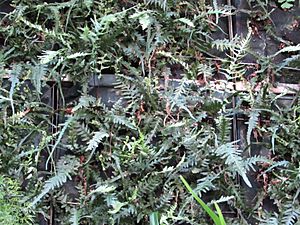Tutwiler's spleenwort facts for kids
Quick facts for kids Tutwiler's spleenwort |
|
|---|---|
 |
|
| Asplenium tutwilerae incorporated into a green wall at Longwood Gardens | |
| Conservation status | |
| Scientific classification | |
| Genus: |
Asplenium
|
| Species: |
tutwilerae
|
Asplenium tutwilerae is a special kind of fern. It is also known as Tutwiler's spleenwort or Scott's fertile spleenwort. This rare fern grows only on rocks in Hale County, Alabama, United States. It is a unique plant that formed from another fern called A. × ebenoides. A. × ebenoides is a mix of two other ferns: A. platyneuron and A. rhizophyllum.
A. tutwilerae looks almost exactly like A. × ebenoides. The main difference is that A. tutwilerae produces healthy, fertile spores, while A. × ebenoides does not. For a long time, scientists thought they were the same species. But in 2007, they were officially recognized as separate. This fern is named after Julia Tutwiler, who first found it in 1873.
Contents
What is Tutwiler's Spleenwort?
Asplenium tutwilerae is a small, green fern that stays green all year. It grows in groups on rocks. This fern has two slightly different types of leaves, called fronds. The larger fronds stand up straight and produce spores. The smaller fronds usually stay flat against the ground.
How Does It Look?
This fern has many thin roots, up to about 2.4 inches (6 cm) long. These roots are connected to a stem called a rhizome. The rhizome can grow sideways or stand upright. It is covered in small, see-through scales that look like stained glass.
The leaf stalks, called stipes, are shiny and brown or purplish-brown. The bottom part of the stalk has scales, and the top part has orange-red hairs. Smaller fronds have shorter stalks, about 0.2 to 1 inch (0.5 to 2.5 cm) long. Larger fronds have longer stalks, about 0.8 to 3.5 inches (2 to 9 cm) long.
Leaves and Stems
The leaves of A. tutwilerae can look very different from one plant to another. They are green and not leathery. Both the leaves and their main stems (called rachides) are covered in hairs. The main stem is brown at the bottom and turns green towards the tip.
On the fertile fronds, the spore cases (called sori) are covered by a thin layer. Inside these cases, there are 64 spores. This fern is a tetraploid, meaning it has four sets of chromosomes.
Different Leaf Shapes
The smaller fronds that hug the ground are shaped like a spear. They are about 0.8 to 4.3 inches (2 to 11 cm) long. The bottom part of these leaves is often cut into small sections called lobes. Sometimes, these sections are cut all the way to the main stem, forming pinnae. The tip of the leaf gets narrower slowly. These smaller fronds sometimes produce spores.
The larger fronds stand up taller and are also spear-shaped. They are about 2.8 to 7.1 inches (7 to 18 cm) long. These fronds are more deeply cut than the smaller ones. The bottom part is cut into pinnae, and the middle part has lobes. Sometimes, new small plants can grow from the tips of these larger leaves.
It can be hard to tell A. tutwilerae apart from A. × ebenoides. The best way is to check their spores. A. tutwilerae has healthy, fertile spores, while A. × ebenoides has spores that are not well-formed and cannot grow.
Where Does It Come From?
Julia Tutwiler, a reformer and educator from Alabama, found this fern in 1873. She discovered it in a deep valley called Havana Glen, near her home. At first, scientists debated if A. × ebenoides was a hybrid (a mix of two different plants). The discovery of this fertile fern made the discussion even more interesting.
Later, in 1953, a scientist named Herb Wagner helped clear things up. He showed that the sterile A. × ebenoides had two sets of chromosomes (it was diploid). But the fertile ferns, like the ones Julia Tutwiler found, had four sets of chromosomes (they were tetraploid). This meant they had formed through a special process where their chromosomes doubled.
In 2007, Brian Keener and Larry Davenport decided that the fertile ferns were different enough to be their own species. They named it A. tutwilerae to honor Julia Tutwiler. This made A. tutwilerae one of the rarest fern species in the world.
Where Does It Grow?
Asplenium tutwilerae is found only in Havana Glen and a few nearby small valleys. In 1982, it was estimated that about 200 to 300 individual ferns grew in Havana Glen itself.
Living Conditions and Protection
Asplenium tutwilerae grows on ledges of a type of rock called conglomerate. This rock contains small, hard pebbles and is rich in iron and a little calcium. The soil that forms from this rock is slightly acidic. The ferns mostly grow on the rocks, which are covered with mosses and lichens, rather than on the forest floor.
Even though A. tutwilerae can sometimes grow new plants from its leaf tips, this is very rare. Most of its reproduction happens through its spores.
The Alabama Plant Conservation Alliance is working to watch over and protect the only wild group of A. tutwilerae ferns.
Growing This Fern
Sometimes, people grow A. tutwilerae in greenhouses or gardens because it is pretty. It grows well in moist soil and likes medium light and high humidity. If you buy A. × ebenoides that was grown from spores, it is actually A. tutwilerae.
A detailed guide on how to grow A. tutwilerae from spores was published in 1949. The spores were planted on peat and grew in a warm room under glass. Young ferns were then moved to a special soil mix. They were kept warm and watered carefully with rain water.


